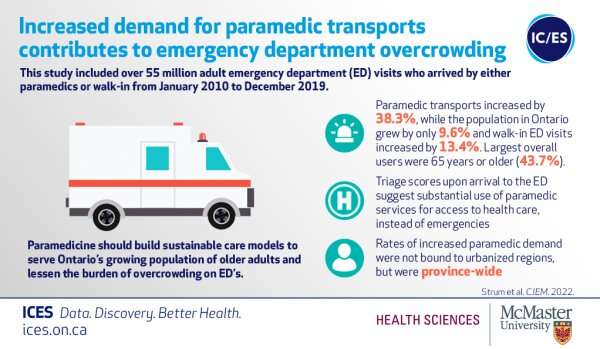Increased demand for paramedic transports contributes to emergency department wait times in Canada

Increase in paramedic transport rates over the last decade far exceeds population growth and walk-in emergency department (ED) visits in Ontario, according to a new study from ICES and McMaster University.
The increased rates of paramedic transports could be a contributing factor to overcrowding and long wait times in hospital EDs. There is a gap in the research exploring changes in paramedic transports compared to population growth and walk-in ED visits.
In this study published in the Canadian Journal of Emergency Medicine, changes in annual paramedic transports in the ten years prior to the COVID-19 pandemic were examined. Patients triaged in the ED who arrived by paramedics or walk-in were included and clustered by geographical region.
The data suggests that paramedic services, like EDs, are experiencing similar operational pressures to provide timely healthcare amid a consistently growing demand for services. Growth of paramedic transports is an unreported contributor to ED overcrowding, as paramedics are restricted from transporting patients to non-ED alternatives.
"Our findings highlight the need for health policy makers to re-evaluate paramedic service organization to reduce ED overcrowding and build sustainable models for prehospital care for the future—especially as transports continue to rise," says lead author Ryan Strum, Ph.D. candidate in the Department of Health Research Methods, Evidence, and Impact at McMaster University.
In the ten years prior to the pandemic, Ontario's overall paramedic transports increased consistently by 38.3%, far outpacing population growth at 9.6% and walk-in visits to the ED at 13.4%.
Patient characteristics and reasons for ED visits remained consistent across the study period, with the largest users of paramedicine being persons aged 65 or older (43.7%) and living in urban areas. However, paramedic transports also increased substantially in rural and northern regions.
"The majority of transports in 2019 had non-emergent triage scores and there was a lot of growth in non-urgent transports, which suggests that citizens are also using paramedics as a means of accessible healthcare, but not strictly for emergency purposes," says Strum.
The study's findings support workforce planning and models of care development to better address the needs of patients who use paramedic services.
"Paramedicine should cultivate new care models that incorporate more primary care integration, with a focus on older adults. By providing more primary care integration, referrals in the community, as well as alternate sub-acute destinations, some patients may not require ED transport, thereby reducing the burden in our EDs," says senior author Andrew Costa, adjunct scientist at ICES and an associate professor of the Department of Health Research Methods, Evidence, and Impact at McMaster University.
More information: Ryan P. Strum et al, Increased demand for paramedic transports to the emergency department in Ontario, Canada: a population-level descriptive study from 2010 to 2019, Canadian Journal of Emergency Medicine (2022). DOI: 10.1007/s43678-022-00363-4



















